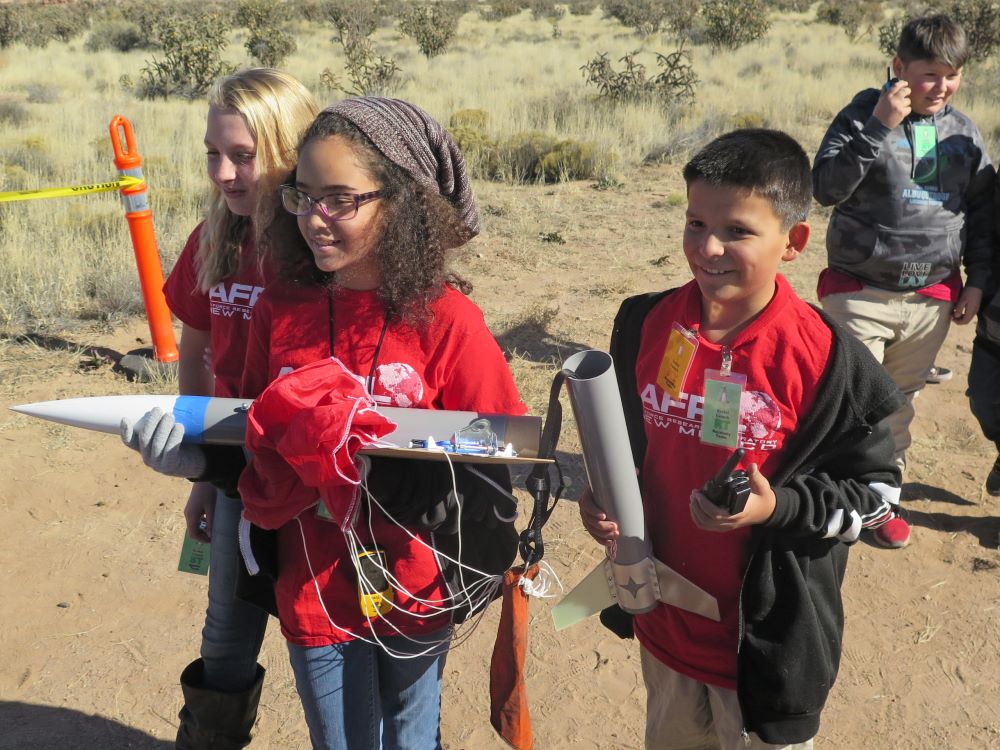Charlie Hurley spent most of his career in college athletics. Before applying for a Spaceport America public information officer job, the former New Mexico State assistant athletics director considered the idea carefully.
“It was an intimidation factor for me. I didn’t have any knowledge base in aerospace, zero,” Hurley said.
Still, he recognized the potential.
“We’ve all seen the projections of space as a $1.2 trillion or $1.3 trillion industry by 2040,” Hurley said.
Public and private organizations in New Mexico are undertaking a concerted campaign to ensure citizens know of opportunities to work in the burgeoning space economy.
Starting in elementary school and continuing through early careers, companies and government agencies are developing curriculum, mentoring and career services to encourage students and young professionals to opt for space-related jobs. They call the concept Pathways to the Stars.
Casey DeRaad, CEO of NewSpace Nexus, an Albuquerque-based nonprofit with a mission to “unite and ignite” the space industry nationally, tells companies, “You can’t just think about the workforce when you’re doing job placement.” She urges executives to fund robotics clubs and rocket programs, provide internships and serve as mentors.
Nationwide demand
Expanding the space workforce is a challenge nationwide. The number of U.S. students working toward engineering degrees has declined annually since 2019. According to the National Student Clearinghouse spring 2023 report, community colleges and vocational schools show similar trends.
Manufacturing jobs, meanwhile, are becoming harder to fill.
“Largely this is due to phenomena where we are seeing the United States increase its manufacturing base writ large,” said Tom Roeder, Space Foundation senior data analyst. “From microchips to automobiles, a lot more things are being built in the United States, largely due to supply chain problems that we experienced during COVID.”
“The space industry is growing by leaps and bounds, but the workforce is not keeping pace with that,” Steve Isakowitz, Aerospace Corp. president and CEO, said in September at the TechCrunch Disrupt conference in San Francisco.
 Middle school students carry the model rocket they launched while participating in an AFRL STEM program in New Mexico. Credit: AFRL
Middle school students carry the model rocket they launched while participating in an AFRL STEM program in New Mexico. Credit: AFRL
Many efforts to expand the space workforce focus in part on attracting women, people of color and employees from other industries. Through Space Workforce 2030, for example, 30 companies have joined forces “to build a stronger, more vibrant and inclusive workforce essential to the future success of our industry. Instead of competing for talent, we are growing talent,” Isakowitz said.
Pathways to the stars
In the United States, Alabama, California, Colorado, Florida and Texas have vibrant space economies, partly thanks to the presence of government and prime contractor facilities and the startups they attract. Arizona, Michigan, New York, Virginia and Washington are among the states making concerted efforts to support existing space businesses and attract new ones.
What’s happening in New Mexico is unusual because of its breadth. Schools and companies are working with local and state agencies and nonprofits like NewSpace Nexus to establish Pathways to the Stars.
New Mexico, with about 2.1 million residents in a state roughly the size of Germany, has the nation’s highest concentration of aerospace jobs per capita, according to the U.S. Bureau of Labor Statistics. As a result, aerospace is of greater relative importance for a state that ranks 36th in population than in states with larger populations and more diverse economies.
“Where we see the biggest challenge is the educational profile of the industry,” said Sarita Nair, cabinet secretary for New Mexico’s Department of Workforce Solutions.
About 27,000 people, or 3.2 percent of the workforce, are tied to New Mexico’s aerospace industry. In July 2023, there were 3,720 advertised job openings for aerospace workers across the state, Nair said.
Most of the openings were research and development related and required highly skilled workers with advanced degrees. But New Mexico colleges and universities only awarded 68 aerospace engineering bachelor’s degrees, two master’s degrees and one doctorate in 2021 and 2022.
“Now, that doesn’t mean that there aren’t people with a broader educational profile that could end up working in the industry,” Nair said. “But it speaks to the strength of the Pathways to the Stars approach. We want people thinking about these careers as they go from middle school to high school, thinking about the classes they want, and as they go from high school to picking a college and picking a major.”
“We need to be exciting people about aerospace because we are now at the place where there’s legitimate demand,” Nair said. “This is no longer, ‘Hey, little 6-year-old, maybe by the time you Right: Middle school students carry the model rocket they launched while participating in an AFRL STEM program in New Mexico. graduate college, there will be a job for you.’ It’s ‘Hey, college sophomore, maybe take these two extra courses because we have a job waiting for you tomorrow.’”
Space Valley
New Mexico has a wealth of military space-related assets at Kirtland Air Force Base, including the Air Force Research Laboratory Space Vehicles and Directed Energy Directorates, the Space Systems Command’s Prototyping and Innovation Directorate and the Space Rapid Capabilities Office.
On the commercial side is Spaceport America. There, anchor tenant Virgin Galactic’s VMS Eve mothership aircraft takes off to send private astronaut customers on suborbital spaceflights in the VSS Unity spaceplane.
 Virgin Galactic’s SpaceShipTwo Unity flies over Spaceport America. Credit: Virgin Galactic
Virgin Galactic’s SpaceShipTwo Unity flies over Spaceport America. Credit: Virgin Galactic
“It’s been the hope and strategy of the state for many years to figure out how to take the strengths in the various disciplines and translate them into commercial opportunities,” said Randy Trask, New Mexico Trade Alliance president. “All of a sudden now, space, an area where we have a huge competitive advantage just happens to be aligned with a sector that could potentially grow into the largest sector we’ve ever seen.”
As a result, the state is looking at ways to help the space sector grow through education, investment and workforce development.
“Workforce is a challenge, unfortunately, right now, through all industry sectors,” Trask said. “It will take regional organization to start making investments in strategic areas where we think workforce is going to be needed. That’s not astrophysicists. That’s a blue-collar workforce that’s trained for when space technologies move into mass production.”
The Space Valley Coalition, which Trask leads as principal investigator, is one of 16 finalists competing for $160 million in National Science Foundation funding over 10 years to expand the region’s commercial space economy. Winners of the NSF Regional Innovations Engines Competition will be selected by the end of the year.
Space Valley stretches from southern New Mexico north to Colorado Springs, home of U.S. Space Command.
“We have an insane amount of assets spread out between Colorado and New Mexico that are all doing very important things,” Trask said. “The goal of the Space Valley Coalition is regional coordination to make them work better together, towards a collective vision.”
Feedback cycle
Space companies often come to New Mexico for government work.
Virginia-based Blue Halo established its first manufacturing facility in Albuquerque “because of the proximity to our customers and the innovative work done here,” Mary Clum, BlueHalo sector general manager and corporate executive vice president, said by email. “And as more industry partners like us choose New Mexico, more federal dollars and resources flow to the state. This synergy has created a feedback cycle driving even more research, investment and resources in the state – as witnessed by the growth of the U.S. Space Force presence in Albuquerque and the potential STARCOM announcement on the horizon.”
The U.S. Air Force named Kirtland Air Force Base as the preferred location for Space Delta 11, the Space Training and Readiness Command unit — STARCOM —in charge of training ranges and squadrons to serve as enemy units for wargames and exercises. A final decision is expected later this year.
BlackSky, based in Herndon, Virginia, has offices in Albuquerque, Denver and Seattle.“We have employees now in 28 states,” said Peter Wegner, BlackSky chief technology officer. “We’ve got to hire the talent wherever we can find it. It’s a very difficult war for talent. And it’s going to get worse in the next five years as the baby boomers hit the peak of retirement.”
As a result, Wegner is building relationships with universities, including schools like New Mexico State University, that help students obtain security clearances while performing national security research projects.
“Then when they graduate, they’re ready to hit the ground running,” Wegner said.
Center of gravity
Ever since Los Alamos was given a lead role in the Manhattan Project to build the atomic bomb, New Mexico has been a hub for national security work. The focus on space is a more recent development.
With the AFRL and Space Force organizations, “you have a natural center of gravity for space science and technology, research and development,” said Stanley Straight, technical director for the Space Systems Command Innovation and Prototyping Acquisition Delta. “In my personal opinion, I think you’ll find that New Mexico is going to become more important within the Space Force activity and to the nation as we build systems that are resilient and ready to protect and defend our national interest.”
Richard Scott Erwin, chief scientist for AFRL’s Space Vehicles Directorate, agreed.
“It’s definitely been building over time,” said Erwin, who moved to New Mexico in 1997. “Between the level of commercial space activity and the buildup of more government-focused organizations, we’re really starting to see a nice ecosystem here for high-tech advanced space capabilities.”
This article originally appeared in the October 2023 issue of SpaceNews magazine.
>>> Read full article>>>
Copyright for syndicated content belongs to the linked Source : SpaceNews – https://spacenews.com/pathways-to-the-stars-creating-a-talent-pipeline-in-new-mexico/































